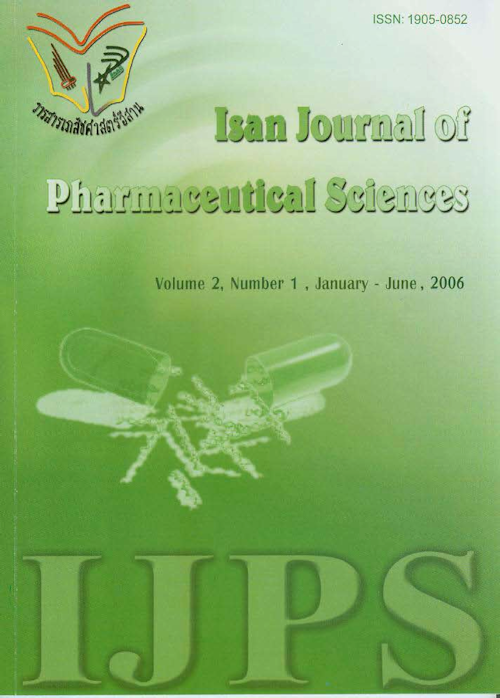Heavy Metals in Some Thai Traditional Drugs and Herbal Extracts
Main Article Content
Abstract
Quantification of 4 heavy metals, namely lead, arsenic, cadmium and iron, in 14 herbal extracts, 12 of which being powdered and 2 oils, and 5 traditional preparations was investigated by using atomic absorption spectroscopy. Herbs used included Morinda citrfolia, Murdannia lorifomis, Androgrphis paniculata, Hibiscus sabdariffa, Terminalia bellirica, Zingiber officinale, Kaempferia parviflora, Streblus asper, Piper retrofractum, Piper nigrum, Terminalia chebula, Curcuma Longa and Hyptis suaveolens; 5 traditional preparations, were included in this study. Lead was not found in 4 of the herbal extracts and 4 of the traditional preparations. Arsenic and cadmium were found in all of the samples at various levels: 12 herbal extracts and 3 traditional preparations with a low level (>0 - < 0.2 ppm) of lead; 9 herbal extracts and 3 traditional preparations with a moderate level (>0.040 - < 0.030 ppm) of cadmium. Iron was found in 11 herbal extracts and 5 traditional preparations, of which 10 herbal extracts and 4 traditional preparations found with not more than 25 ppm. The highest level of lead, at 12.9 + 2.2 ppm, was found in water extracts of dried fruits of Morinda citrfolia. Murdannia lorifomis, extracted by pressing juices from fresh leaves without solvents, gave high levels of lead, cadmium and iron. Androgrphis paniculata extract from dried leaves also gave high levels of lead and cadmium. 4.29 + 0.05 ppm of lead was found in one of the traditional preparations but lower than the WHO minimum allowance level. It shows that some heavy metals were retained in these herbal extracts and traditional preparations. The extraction could be one of the factors involved. Control of toxic heavy metals in herbal extracts and/or traditional preparations is one of the vital indications for quality assurance.
Article Details
In the case that some parts are used by others The author must Confirm that obtaining permission to use some of the original authors. And must attach evidence That the permission has been included
References
Chao C.C., Aust A.E. (1993) Photochemical reduction of ferric iron by chelators results in DNA strand breaks. Arch. Biochem. Biophys. 300:544-550.
Chizzola R., Michitsch H., Franz C. (2003) Monitoring of metallic micronutrients and heavy metals in herbs, spices and medicinal plants from Austria. Eur. Food Res. Technol. 216:407-411.
Chow P. Y. T., Chua T. H., Tang K. F., Ow B. Y. (1995) Dilute acid and digestion procedure for the determination of lead, copper,and mercury in traditional Chinese medicines by automic absorption spectroscoppy. Analist. 120:1221-1223.
Chuang P.Y.T.,Chen K.S.,Huang YL, Lee P.N., Lin T.H. (2000) Determination of trace eiement in some natural drugs by atomic absorption spectrometry, biol. Trace Element Res. 76(3):235-244.
Das P., Samanrtaray S., Rout G.R. (1997) Studies on cadmium toxicity in plants: a review. Environ. Poll. 98(1): 29-36.
Ernst E. (2002) Heavy metals in traditional Indian remedies. Ear. J. Clin. Pharmacol. 57: 891-896.
Flick D.F., Kraybill H.F., Dlmitroff J.M. (1971) Toxic effects of cadmium: a review. Environ. Res. 4(2):71-85.
Groten J.P., Bladeren P.J.V. (1994) Cadmium availability and health risk in food. Trends Food Sci. Tech. 5:50-55.
Hsu p. and Guo Y.L. (2002) Antioxidant nutrients and lead toxicity. Toxicology. 180: 33-44.
Kroemer G. (1999) Arsenic trioxide, a novel mitochodriotoxic anticancer agent. J. Natl. Cancer Inst. 91:743-745.
Linseman K.L., Larson P., Braughler J.M., McCall J.M. (1993) Iron-initiated tissue oxidation: Lipid peroxidation, vitamin E destruction and protein thiol oxidation. Biochem. Pharmacol.45:1477-1482.
Mandal B.K. and Suzuki K.T. (2002) Arsenic round the world : a review. Taianta. 58: 201-235.
Minotti G., Aust S.D. (1987) The role of iron in the initiation of lipid peroxidation. Chem. Phys. Lipids. 44:191-208.
Prasad M.N.V. (1995) Cadmium toxicity and tolerance in vascular plants. Environ. Expen. Botany. 35(4):525-545.
Stohs S.J. and Bagchi D. (1993) Oxidative mechanisms in the toxicity of metal ions. Free Radic. Biol. Med. 18(2): 321-336.
Wen K.C. (2000) The turnover rate of marker constituents in Chinese herbal medicine. J Food Drug Anal. 8(4):270-277.
World Health Organization (1999) WHO monographs on selected medicinal plants. Vol 1 Geneva:World Health Organization.
World Health Organization (2004) WHO Guidelines on Development Consumer Information on Proper Use of Traditional, Complementary and Alternative Medicine. GenevarWorld Health Organization.

